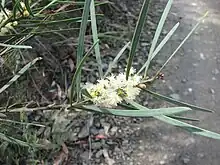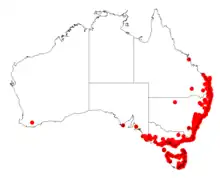Acacia suaveolens
Acacia suaveolens (sweet wattle) is a shrub species endemic to Australia.[2] It grows to between 0.3 and 3.5 metres high and has smooth purplish-brown or light green bark and has straight or slightly curving blue-green phyllodes [3][4] The pale yellow to near white globular flower heads generally appear between April and September in its native range.[3] These are followed by flattened, bluish oblong pods which are up to 2 to 5 cm long and 8 to 19 mm wide.[3][4]
| Acacia suaveolens | |
|---|---|
 | |
| Acacia suaveolens at Anglesea Heath, Victoria | |
| Scientific classification | |
| Kingdom: | Plantae |
| Clade: | Tracheophytes |
| Clade: | Angiosperms |
| Clade: | Eudicots |
| Clade: | Rosids |
| Order: | Fabales |
| Family: | Fabaceae |
| Subfamily: | Caesalpinioideae |
| Clade: | Mimosoid clade |
| Genus: | Acacia |
| Species: | A. suaveolens |
| Binomial name | |
| Acacia suaveolens | |
 | |
| Occurrence data from AVH | |
| Synonyms | |
| |
The species was first formally described by English botanist James Edward Smith in 1791 in Transactions of the Linnean Society of London He described it with reference to a cultivated plant at Syon House which had been raised by Thomas Hoy from seed that originated from New South Wales.[1] The species was transferred into the genus Acacia by Carl Ludwig Willdenow in 1806.[1]
The species occurs naturally on sandy soils in heathland and dry sclerophyll forest in South Australia and Victoria, Tasmania, New South Wales and Queensland.[3]
Cultivation
This species provides winter colour in a garden and may be used as a low screen plant.[4]
References
- "Acacia suaveolens". Australian Plant Name Index (APNI), IBIS database. Centre for Plant Biodiversity Research, Australian Government, Canberra. Retrieved 2009-09-17.
- "Acacia suaveolens". World Wide Wattle. Retrieved 2009-09-25.
- "Acacia suaveolens". PlantNET - New South Wales Flora Online. Royal Botanic Gardens & Domain Trust, Sydney Australia. Retrieved 2009-09-21.
- Greig, D. (1987). The Australian Gardener's Wildflower Catalogue. Australia: Angus & Robertson. ISBN 978-0-207-15460-7.